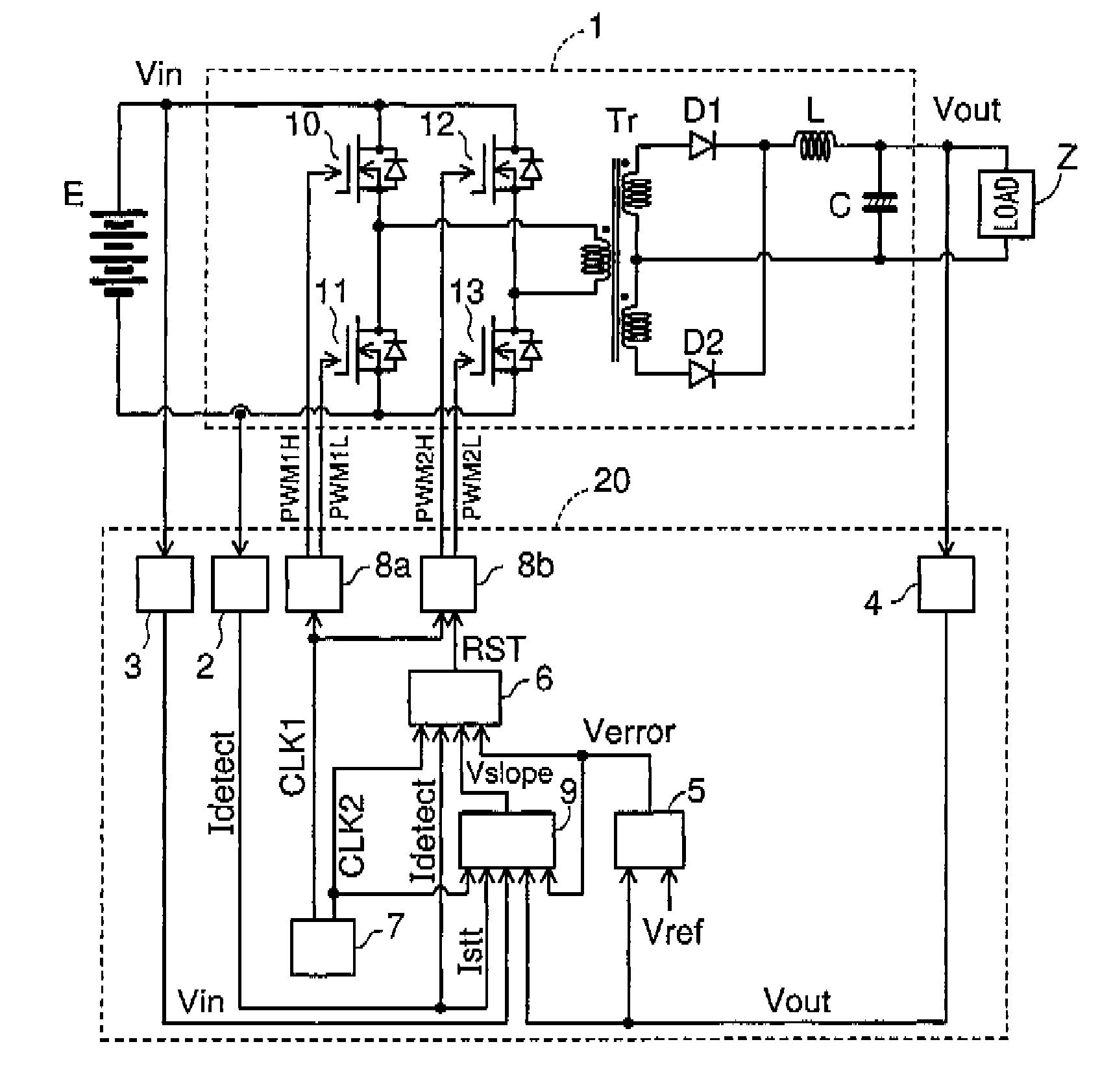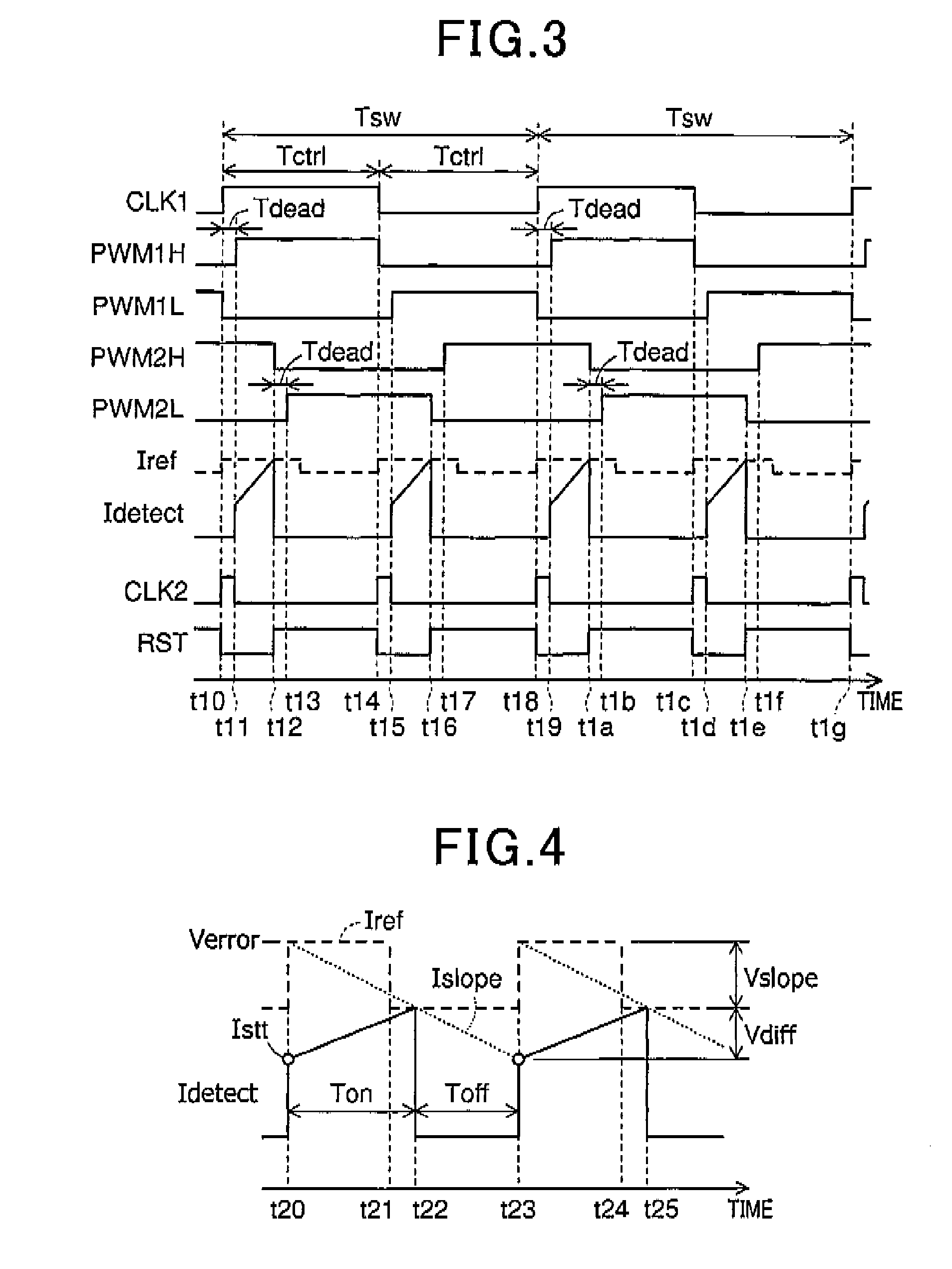Current mode controlled power converter
a power converter and current mode technology, applied in the field of current mode control power converters, can solve the problems of increasing the number of components, increasing not only the manufacturing cost, but also the converter dimension, and the updating delay, so as to reduce the manufacturing cost and converter dimensions, prevent subharmonic oscillation reliably, and extend the input and output voltage range available for digital current mode control.
- Summary
- Abstract
- Description
- Claims
- Application Information
AI Technical Summary
Benefits of technology
Problems solved by technology
Method used
Image
Examples
first embodiment
[0030]There will now be explained a first embodiment with reference to FIG. 1 to FIG. 5, and FIG. 11, where, for each control cycle, a slope compensation signal calculated on the basis of an error signal prior to the control cycle is negated. A car shown in FIG. 1 is provided with a power converter including a switching section 1 and a control section 20. The switching section 1 and the control section 20 may be separate from each other, where the switching section 1 may also be referred to as a switching unit, or may be integrated together. FIG. 2 shows an exemplary configuration of the switching section 1 and the control section 20.
[0031]As shown in FIG. 2, the switching section 1, which serves as a so called DC-DC converter, converts an input voltage value Vin into a desired voltage value through the switching operation and outputs the voltage of the desired voltage value. The switching section 1 includes switching modules 10, 11, 12, 13, a transformer Tr, diodes D1, D2, a reacto...
second embodiment
[0062]There will now be explained the second embodiment of the present invention with reference to FIG. 6 to FIG. 8, and FIG. 11, where the slope compensation signal is negated on the basis of the reference signal or the reset signal. Only differences of the second embodiment from the first embodiment will be explained. Elements having the same functions as in the first embodiment are assigned the same numbers and will not be described again for brevity.
[0063]The power converter, including the switching section 1 and the control section 20, of the present embodiment shown in FIG. 6 differs from the power converter, including the switching section 1 and the control section 20, of the first embodiment shown in FIG. 1 in that the slope compensation unit 9 further receives the reset signal RST outputted from the reset signal generation unit 6. The slope compensation unit 9 is configured such that the slope compensation signal Vslope is negated on the basis of the reference signal CLK2 o...
third embodiment
[0075]There will now be explained a third embodiment of the present invention with reference to FIG. 9 to FIG. 11, where, as in the second embodiment, the slope compensation signal is negated on the basis of the reference signal or the reset signal. Only differences of the third embodiment from the first and second embodiments will be explained. Elements having the same functions as in the first and second embodiments are assigned the same numbers and will not be described again for brevity.
[0076]FIG. 9 shows a block diagram of the reset signal generation unit 6, as alternative to the reset signal generation unit 6 shown in FIG. 7. In the third embodiment, the slope compensation is performed by adding the slope compensation signal Vslope to the current detection signal Idetect while in the second embodiment the slope compensation is performed by subtracting the slope compensation signal Vslope from the error signal Verror.
[0077]The reset signal generation unit 6 shown in FIG. 9 incl...
PUM
 Login to View More
Login to View More Abstract
Description
Claims
Application Information
 Login to View More
Login to View More - R&D
- Intellectual Property
- Life Sciences
- Materials
- Tech Scout
- Unparalleled Data Quality
- Higher Quality Content
- 60% Fewer Hallucinations
Browse by: Latest US Patents, China's latest patents, Technical Efficacy Thesaurus, Application Domain, Technology Topic, Popular Technical Reports.
© 2025 PatSnap. All rights reserved.Legal|Privacy policy|Modern Slavery Act Transparency Statement|Sitemap|About US| Contact US: help@patsnap.com



